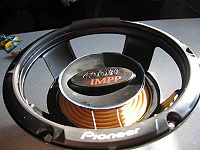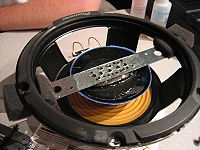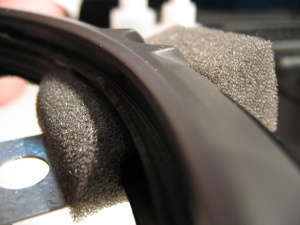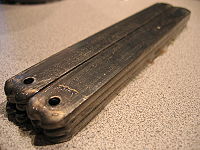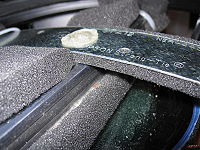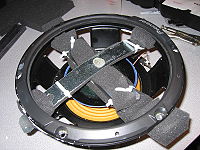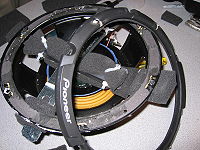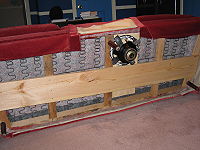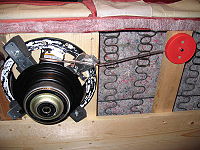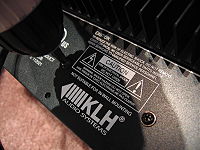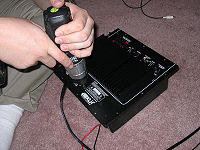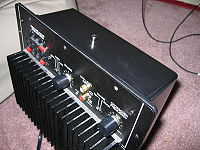Tactile Transducer
| Tactile Transducer | |
|---|---|
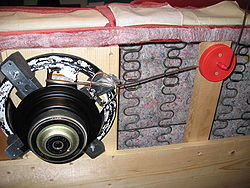
Mounted Transducer | |
| Information | |
| Owner | Mikemsd |
| Version | 1.0 |
| Started On | October 2004 |
| Cost | Unknown |
| Media | |
Overview
This project was based on an article about building a tactile transducer out of a speaker for mounting to a couch. This was built with a friend of mine that has since moved away, taking the couch with him. The tactile transducer was built to hook into the sub output on a home theater set up and provide a tactile rumble in the seating for low frequency noises such as explosions. I did this project 6 years ago, so I will attempt to reconstruct it along with my thoughts at the time. Some steps may be missing or omitted. Since you will be working with lead and some high voltages, take all appropriate precautions. This project should be attempted by adults only, or at the very least with the supervision of an adult.
Features
- Built using old Pioneer car sub speaker and KLH sub amp.
- Plug built into couch to allow for easy movement.
- Sub amp modified to add cooling and add plug to top.
Parts
- Transducer
- Sub Amp
- Sub Speaker
- Lead Weights (Available at outdoor goods stores, typically used to make home made fishing weights)
- Epoxy (We used 30 minute)
- Foam cushioning
- Flexible aluminum strips
- Couch Mounting
- 1x8 Wooden board
- Speaker connector (I used an RCA jack)
- Speaker wire
- Wood Glue
- Wood Screws
Tools Required
- Latex Gloves (You are handling lead of course)
- Saw of some sort to cut 1x8 board
- Screwdriver
- Drill
- Disposable Mixing Cups
Construction
Speaker
- Outer cone is removed from speaker
- I used an exacto hobby knife for this process to ensure a clean cut.
- Cut foam for cushioning and mount initial aluminum strip.
- Foam prevents vibration noises from the metal to metal contact. This speaker should be felt not heard.
- Foam and aluminum bar should be underneath metal ring surrounding speaker, not just under the plastic trim strip.
- Trim strip was removed at the end of this project to flush mount speaker to couch.
- We used an aluminum strip with pre-drilled holes in the center. This allows the epoxy to get a better grip.
- Mix epoxy and fill inner cone connected to driven element.
- Epoxy binds the aluminum strip to the driven element.
- Allow epoxy to set before continuing.
- Epoxy together lead weights. We used six weights for this.
- There is a balance to reach here. Too many weights and the driver can successfully move them, too little and you won't feel the rumble.
- These weights are commonly available at outdoor stores. They are sold in the fishing department. They are used by people making their own weights.
- Attach lead weights to aluminum bar
- Sandwich the weights with foam strips for best results.
- We used zip ties to secure the weights and foam.
- Use another aluminum strip over the top to hold the assembly in place.
- Use more foam on top strip to prevent metal on metal contact.
- The strips should have enough give for the element to move.
- Trim strip removed as promised.
- Allowed for flush mounting to couch.
Couch
- Cut 1x8 to length of couch. Mount to bottom of couch.
- Secure to couch with both wood glue and screws.
- This board should be secured well to the couch body.
- Transmits vibrations across the whole couch so speaker vibrations are not localized.
- (Optional) Cut section of 1x8 and mount behind cross member.
- On this couch, speaker would have touched ground if mounted to the cross member.
- Used wood glue to attach to couch frame and wood glue and screws to attach to cross member.
- Mount speaker
- Add RCA Jack
- We decided to add a RCA jack to make for easy movement of the couch.
Amp
- These steps will vary greatly depending on your amp.
- This is extremely hazardous, the capacitor in this amp stores a large current and can kill you.
- If you can modify the amp without opening it, that would probably be better.
- Amp Modification
- Note clearly labeled warnings
- You can see original design with wires coming out of the bottom of the amp.
- Added RCA plug to top of amp.
- Further Modifications
- We went back and added some active cooling to this amp. We discovered that during use, this amp became extremely hot. This is because it was not meant to drive a lead weight. Holes were drilled in the side of the case on both sides and a 12 volt computer case fan was added. The fan was powered via an external 12 volt wall wart variable voltage supply. The selector on the supply allowed us to dial up and down the cooling depending on demand.
Epilogue
You'll probably notice that we are using a KLH amp, and a Pioneer speaker. The amp came out of a KLH sub that we dismantled for this project. We bought it and dismantled it, solely for the amp. There are plenty of cheap 12 volt car sub amps out there, but not too many cheap 110 volt house sub amps. We discovered this after building the transducer and having nothing to drive it with. You may wonder what happened to the KLH speaker that obviously came with the amp.
Unfortunately, this is where the story of the rumble couch takes a turn for the worse and heads for it's end. The friend which I designed this project with continued on against advisement and added the KLH speaker as another tactile transducer. As you may have read above, the sub amp was already running extremely hot. Unfortunately this spelled the end of the amp. After attempting to drive two speakers worth of lead weights, it finally had a meltdown. With a lingering smell of ozone in the air, the rumble couch is no more.
This project was a real learning experience for me. This was one of the first real home brew projects I undertook and it taught me a lot. The initial instructions we read were very light on detail, but it did seem doable. The initial supplies were fairly cheap as we already had the speaker. Once we determined we could assemble the transducer, that's when things got a little expensive as we improvised a way to drive it. If you decide to undertake this project, I hope you have as much fun as I did. Please post in the discussion and let me know how it turns out for you.
